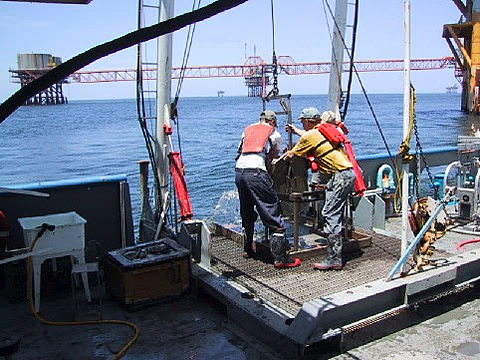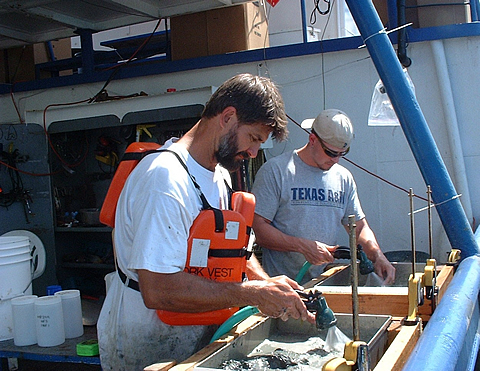The need to drill increasingly difficult deepwater and deviated wells, coupled with the economic and safety advantages of ocean discharge of cleaned cuttings, has led the offshore oil and gas industry to develop SBMs: drilling muds in which synthetic materials are the carrier fluid. They are designed to be less toxic and to degrade faster in marine sediments than oil-based drilling muds, while providing similar technical advantages in drilling difficult wells.
The U.S. Environmental Protection Agency (EPA) regulates discharges to water from offshore operations. In 1996, EPA recognized SBMs as a new class of drilling muds and began reviewing cuttings-treatment technologies and the environmental impacts of drilling cuttings disposal options. In addition to the requirements for ELGs, EPA Region 6 general permits requires operators to either conduct seabed surveys at each location where cuttings drilled with SBMs are discharged or to participate in a joint-industry seabed survey study.
Project Results
The program performed systematic evaluation of the SBMs by collecting samples from four cruises in the Gulf of Mexico. Samples were collected and analyzed for physical, chemical, and biological parameters related to the distribution of SBM cuttings accumulations on the bottom, as well as the general characteristics of the benthic communities. There was a sharp decrease in concentrations of cuttings and chemicals in sediments with distance from the discharge sites, which indicates that drill cuttings solids, especially from SBM cuttings, are deposited close to the discharge site. No large, multimeter-thick cuttings piles, such as those seen in the North Sea, were detected at any of the 15 sites visited in the study. Discharges were limited to the vicinity of an area 250 meters from discharge locations.
Benefits
The review provided input for the development of Effluent Limitation Guidelines (ELGs), which include technology-based limitations for the discharge of cuttings generated during drilling with SBMs. Most sediment concentrations of metals associated with drilling muds were within the range of concentrations for uncontaminated marine sediments. Evidence was found that indicated that organic enrichment of discharge sites from physical and chemical disturbances recovered over time. Significant improvement was observed in the one year between sampling cruises. In general, sediment quality and biological communities were not severely affected, and impacts were limited to the vicinity of the discharge (<250 meters).
Project Summary
The research was sponsored by a consortium of companies-the SBM Research Group, comprised of offshore operators and mud companies-DOE, and MMS.
As of June 1, 2002, the contractor had completed all four sampling cruises. Initially, 10 sites on the continental shelf were surveyed, and three were chosen for extensive sampling and analysis. Three locations from the continental slope also were selected for surveys during the third and fourth cruises. Samples were collected for analysis of grain size and mineralogy; SBMs and total petroleum hydrocarbons; metals (aluminum, barium, mercury, and iron); total organic carbon; and carbonate. Fauna samples and sediment toxicity samples also were collected and analyzed. During the second cruise, two cores were collected at each of the 8 sites and vertically sectioned in 1- to 2-cm (or other appropriate) increments. These sections then were analyzed separately for grain size, metals, and SBMs to investigate vertical layering. Sediment-profile camera images were collected in the field and are being analyzed.
Elevated concentrations of barium, a tracer of drilling mud; the synthetic chemical-based fluid; and total petroleum hydrocarbons were detected in sediments from the near-field and mid-field zones at the research sites. Most cuttings were deposited within 100-250 meters of the discharge site on both continental and continental slope water-depth sites. Based on observations, sediment concentrations of metals (other than barium) associated with drilling muds were within the range of concentrations for uncontaminated marine sediments. Metal ratios indicated that much of the finer-grained sediments near the offshore platforms were from terrigenous sources.
Measurements of oxygen, total organic carbon, reduction/oxidation potential, and manganese in sediments-all signs of possible SBM cuttings-related organic enrichment-indicated that such enrichment occurred near the discharge locations. Samples collected from multiple survey cruises indicated that the severity of disturbance in the sediments near the discharge location decreased or the sites recovered over time.
Sediment toxicity was measured using a non-indigenous, coastal benthic amphipod. Amphipod survival exceeded 75% in all far-field samples on continental shelf and continental slope sites, and these sediments were not considered toxic. At a small number of sites, less than 250 meters from the discharge locations, amphipod survival was less than 50%, and sediment toxicity and SBM concentrations were correlated. One-year tests of the sites suggested that the habitat quality of the sediments had not been seriously degraded by a long history of discharges at these sites.





